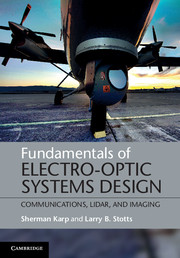Book contents
- Frontmatter
- Contents
- Preface
- Notation
- 1 Genesis of electro-optic systems
- 2 Role of electromagnetic theory in electro-optics systems
- 3 Photo-detection of electromagnetic radiation
- 4 Metrics for evaluating photo-detected radiation
- 5 Contrast, visibility and imaging
- 6 Signal modulation schemes in optical communications
- 7 Forward error correction coding
- 8 Modern communications designs for FOC/FSOC applications
- 9 Light detection and ranging
- 10 Communications in the turbulence channel
- 11 Communications in the optical scatter channel
- Appendix A Two-dimensional Poisson processes
- Appendix B Propagation of finite beams in water
- Appendix C Non-Lambertian scattering
- Appendix D Communications noise sources besides signal/background shot noise
- Index
- References
10 - Communications in the turbulence channel
Published online by Cambridge University Press: 05 February 2013
- Frontmatter
- Contents
- Preface
- Notation
- 1 Genesis of electro-optic systems
- 2 Role of electromagnetic theory in electro-optics systems
- 3 Photo-detection of electromagnetic radiation
- 4 Metrics for evaluating photo-detected radiation
- 5 Contrast, visibility and imaging
- 6 Signal modulation schemes in optical communications
- 7 Forward error correction coding
- 8 Modern communications designs for FOC/FSOC applications
- 9 Light detection and ranging
- 10 Communications in the turbulence channel
- 11 Communications in the optical scatter channel
- Appendix A Two-dimensional Poisson processes
- Appendix B Propagation of finite beams in water
- Appendix C Non-Lambertian scattering
- Appendix D Communications noise sources besides signal/background shot noise
- Index
- References
Summary
Introduction
Since lasers were invented in 1964, optical communications has been investigated for both military and commercial application because of its wavelength and spectrum availability advantages over radio frequency (RF) communications. Unfortunately, only fiber optic communications (FOC) systems have achieved wide implementation since then because of their ability to maximize power transfer from point to point while also minimizing negative channel effects. Recently, free-space optical communications (FSOC) has reemerged after three decades of dormancy due to the availability of new FOC technologies to the FSOC community, such as low-cost sensitive receivers and more power-efficient laser sources. Applications of FSOC, however, have been limited to local area (short range) networking because optical systems have been unable to effectively compensate for two atmospheric phenomena; cloud obscuration and atmospheric turbulence. Making a hybrid FSOC/RF communications system will compensate for cloud obscuration by using the RF capability when “clouds get in the way”. For this chapter, we will discuss how to mitigate the atmospheric turbulence for incoherent communications systems. In particular, we will discuss a new statistical link budget approach for characterizing FSOC link performance, and compare experimental results with statistical predictions. We also will comment at the end of the chapter on progress in coherent communications through turbulence. For those readers interested in science and modeling of laser propagation through atmospheric turbulence, we refer them to several excellent books on the topics for the details [1–5].
- Type
- Chapter
- Information
- Fundamentals of Electro-Optic Systems DesignCommunications, Lidar, and Imaging, pp. 179 - 248Publisher: Cambridge University PressPrint publication year: 2012



